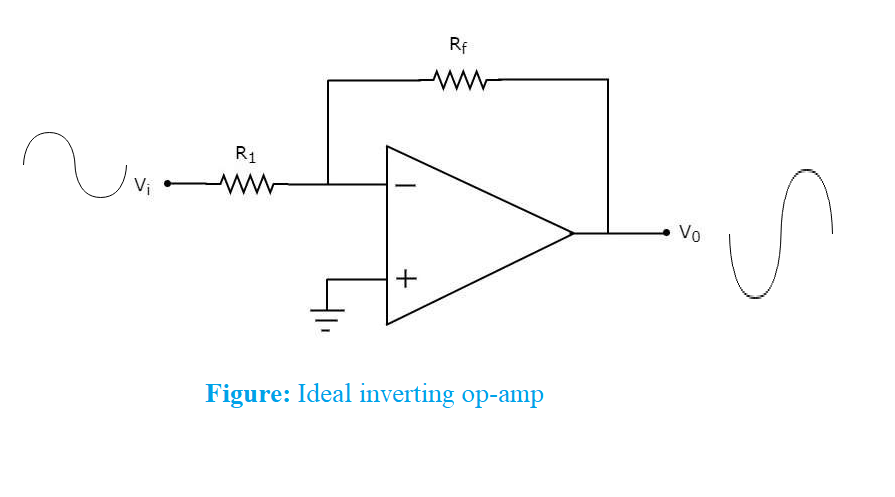
In an inverting amplifier, what must be the phase difference between input and output voltages?
Answer
571.5k+ views
Hint: Amplifier is a device which is used to increase the amplitude of electric signals. Amplifier which inverts the input voltage is known as an inverting amplifier.
The inversion in phase is due to the feedback being negative in value. Negative feedback occurs when a part of output voltage is connected to inverting input of op-amp.
Complete answer:
Amplifier is an electronic device which increases one or more of the input signal’s parameters, voltage, current, or power.
An inverting amplifier is that amplifier in which the output is 180 degrees out of phase with the input. A non-inverting amplifier is that in which the output is in phase with the input.
Therefore, for an amplifier to be inverting there must be a phase difference of ${{180}^{{}^\circ }}$ between input and output voltages.
Additional Information:
An ideal Operational Amplifier or op-amp has following characteristics:
1. It has infinite input impedance.
2. It has zero output impedance
3. It has infinite bandwidth
4. It has infinite open loop gain
Therefore, we apply a resistance between the negative terminal of the op-amp and the output terminal. This resistance is called negative feedback resistance and is denoted by R with subscript f i.e. ${{R}_{f}}$
An op-amp, with configuration shown below, behaves as an inverting amplifier.

Note:
Inverting amplifier has a phase difference of ${{180}^{{}^\circ }}$ between input and output voltage.
Non-inverting amplifier, as the name suggests, does not invert the phase of the input signal.
Output voltage ${{V}_{o}}$ of an inverting amplifier is ${{V}_{o}}=-\dfrac{{{R}_{f}}}{{{R}_{1}}}{{V}_{i}}$, where ${{R}_{f}}$, ${{R}_{1}}$ and ${{V}_{i}}$ are as shown in figure.
The inversion in phase is due to the feedback being negative in value. Negative feedback occurs when a part of output voltage is connected to inverting input of op-amp.
Complete answer:
Amplifier is an electronic device which increases one or more of the input signal’s parameters, voltage, current, or power.
An inverting amplifier is that amplifier in which the output is 180 degrees out of phase with the input. A non-inverting amplifier is that in which the output is in phase with the input.
Therefore, for an amplifier to be inverting there must be a phase difference of ${{180}^{{}^\circ }}$ between input and output voltages.
Additional Information:
An ideal Operational Amplifier or op-amp has following characteristics:
1. It has infinite input impedance.
2. It has zero output impedance
3. It has infinite bandwidth
4. It has infinite open loop gain
Therefore, we apply a resistance between the negative terminal of the op-amp and the output terminal. This resistance is called negative feedback resistance and is denoted by R with subscript f i.e. ${{R}_{f}}$
An op-amp, with configuration shown below, behaves as an inverting amplifier.

Note:
Inverting amplifier has a phase difference of ${{180}^{{}^\circ }}$ between input and output voltage.
Non-inverting amplifier, as the name suggests, does not invert the phase of the input signal.
Output voltage ${{V}_{o}}$ of an inverting amplifier is ${{V}_{o}}=-\dfrac{{{R}_{f}}}{{{R}_{1}}}{{V}_{i}}$, where ${{R}_{f}}$, ${{R}_{1}}$ and ${{V}_{i}}$ are as shown in figure.
Recently Updated Pages
A man running at a speed 5 ms is viewed in the side class 12 physics CBSE

The number of solutions in x in 02pi for which sqrt class 12 maths CBSE

State and explain Hardy Weinbergs Principle class 12 biology CBSE

Write any two methods of preparation of phenol Give class 12 chemistry CBSE

Which of the following statements is wrong a Amnion class 12 biology CBSE

Differentiate between action potential and resting class 12 biology CBSE

Trending doubts
What are the major means of transport Explain each class 12 social science CBSE

Which are the Top 10 Largest Countries of the World?

Draw a labelled sketch of the human eye class 12 physics CBSE

Explain sex determination in humans with line diag class 12 biology CBSE

Explain sex determination in humans with the help of class 12 biology CBSE

Differentiate between homogeneous and heterogeneous class 12 chemistry CBSE




